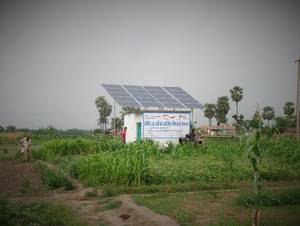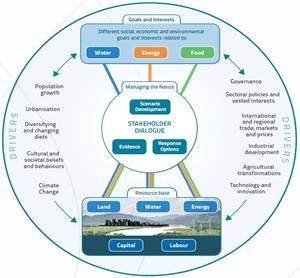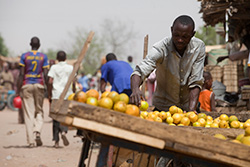Water–energy–food nexus
With a view to drawing attention to the interrelated nature of global resource systems, FAO is exploring how the water–energy–food nexus can support food security and sustainable agriculture worldwide. Population growth, rapid urbanization, changing diets and economic development are just some of the factors driving increased demand for water, energy and food. Agriculture is the largest consumer of the world's freshwater resources, and more than one-quarter of the energy used globally is expended on food production and supply. Feeding a global population expected to reach 9 billion people by 2050 will require a 60 percent increase in food production.
"The water–energy–food nexus is about understanding and managing often-competing interests while ensuring the integrity of ecosystems."
Developing a conceptual approach
The first challenge in dealing with the water–energy–food nexus is to understand it. At its 24th session, the Committee on Agriculture (FAO’s main technical advisory committee) approved FAO’s “Water Governance for Agriculture and Food Security” programme, specifically mentioning the water–energy–food nexus. With this mandate, FAO embarked on a process to define what the nexus means for the food and agriculture sector.
The result of that process is a conceptual approach that revolves around the complex and interlinked uses of water, energy and food. The approach distinguishes between natural resources on the one hand and, on the other, the various goals and interests to be achieved with the same (limited) resources. The water–energy–food nexus is about understanding and managing these often-competing interests while also ensuring the integrity of ecosystems. FAO has identified four areas of work through which it can help manage the nexus:
- by providing evidence;
- by developing scenarios;
- by designing and appraising response options; and
- by supporting multistakeholder dialogue.
From concept to action
The second challenge is to put the water–energy–food nexus concept into action. FAO is doing this in several ways, as illustrated below.
Transboundary nexus assessments with UNECE
Given its cross-cutting nature, putting the water–energy–food nexus concept into action means developing new partnerships among FAO’s technical divisions and external agencies and stakeholders.
FAO is an active member of a UNECE-led task force established at the sixth session of the Parties to the Convention on the Protection and Use of Transboundary Watercourses and International Lakes (Rome, 28–30 November 2012) to oversee assessments of the water–energy–food–ecosystem nexus in selected transboundary basins. FAO provided guidance and expertise on the assessments’ methodologies and processes, especially for the Syr Darya Basin.
The assessments took stock of the state of land, water and energy resources and ecosystems by describing the governance systems in the selected transboundary basins and the interlinkages between sectors, taking into account the impacts of climate change and socio-economic drivers. The assessments were discussed with a broad range of stakeholders from the countries and sectors involved.
The final report of the assessments is available here.
Responsible solar irrigation

Especially in water-scarce countries, the provision of cheap energy for pumping groundwater for irrigated agriculture can lead to groundwater depletion and a loss of water quality, with potentially severe consequences for those who have come to depend on groundwater irrigation. Avoiding the problems of groundwater depletion, therefore, requires strongly coherent policies on energy, land use and irrigation.
Solar irrigation is an increasingly reliable, relatively low-cost, clean-energy solution for agricultural water management in areas with high incident solar radiation. In many rural areas, solar irrigation initiatives can be a way of providing broader access to energy for agriculture, as well as for other uses in rural areas where reliable access to electricity is lacking or diesel is expensive. Some countries are promoting solar irrigation in the framework of national action plans against climate change as a way of reducing greenhouse gas emissions in agriculture.
Although the promise of solar-powered irrigation systems is great, such systems also have the potential to threaten aquifers in the same way that pumps powered by free or subsidized grid electricity have done in the past. Solar pumps potentially offer 2 300–2 500 hours of uninterrupted, daytime energy per year; their low cost and year-round availability could encourage farmers to overuse groundwater, and their decentralized character makes them challenging to regulate.
Energy subsidies and other financing mechanisms can be used to promote solar-powered irrigation systems and to regulate water use – such as by making payments conditional on the use of water-efficient agricultural practices. On the other hand, such subsidies could distort the benefits and costs of solar-powered systems and mask their long-term competitiveness compared with other energy sources. Food-security strategies and agricultural policies also play roles in determining how water is allocated and should be reviewed in the context of water scarcity and climate change.
Technical training for private pump owners, irrigation managers, agricultural extension officers, technical government staff and non-governmental organizations can help in building a local knowledge base and sense of responsibility for the sustainable use of solar irrigation systems.
Food losses and waste
The demand for environmental resources is increasing globally as populations and incomes grow. Undoubtedly there is a need to increase production to meet future demand, but it is also necessary to make better use of the food that is already being produced.
Food losses and waste (FLW) are a missed opportunity to improve global food and nutrition security, a squandering of environmental resources, and a contributor to climate change. FAO calculated the global blue-water footprint of FLW (that is, the quantity of water consumed each year in food losses and waste) at about 250 km3, which is equivalent to three times the volume of Lake Geneva. Produced but uneaten food accounts for about 1.4 billion hectares of land, which is almost 30 percent of the world’s agricultural land area. Intensive farming practices that do not allow fields to lie fallow and replenish contribute to soil degradation and excessive pressure on soil resources.
Reductions in FLW can be found almost everywhere in the food system – in primary production and at every subsequent point in the supply chain to the final consumer. For example, FLW can be reduced by improving farming practices, storage infrastructure, contractual agreements, the investment environment and social capacities, and by raising awareness. A better balance is needed between supply and demand, and efforts should be made to ensure that overproduction is turned to good use.
The environmental footprint of FLW can be reduced by re-using (e.g. for animal feed), recycling and recovering (e.g. for commercial or charitable redistribution for human consumption) throughout the supply chain. Approaches such as recycling, anaerobic digestion, composting and incineration enable the recovery of energy and nutrients from waste foods and by-products and reduce the need for landfill.
The Nexus footprint of an average meal. This infographic presents typical values of water and energy consumed in the production of selected food items. Water is expressed in litres, nutritional energy is expressed in calories, and energy is expressed as the number of hours a 20-watt bulb can run on an equal amount of energy.



